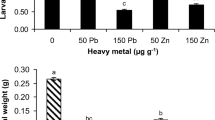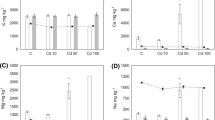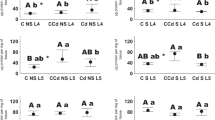Abstract
The artificial diets mixed with various concentrations of nickel were offered to the larvae of the phytophagous insect Spodoptera litura Fabricius for 3 generations. Nickel accumulations in the 6th instar larvae, pupae and newly emerged adults of the corresponding generations of S. litura were investigated by inductively Coupled Plasma-Atomic Emission Spectrometer (ICP-AES), and the effects of nickel accumulations on the survival rate of S. litura were also evaluated by individual rearing. The results showed that nickel accumulated in the 6th instar larvae, pupae and adults of S. litura, and the accumulated nickel in all the tested developmental stages within a generation increased with the increase of the nickel doses in the treated diets and showed significant dose-dependent relationship with the nickel doses in the artificial diets. The results also indicated that the nickel accumulations in the 6th instar larvae, pupae, and newly emerged adults from the 3rd generation were higher than those from the 2nd generation, which were also higher than those from the 1st generation. Nickel concentrations in pupae and adults were significantly lower than those in larvae, which indicated that the excessive nickel might be excreted during metamorphosis. Furthermore, larval survival rate, pupation rate and eclosion rate of S. litura in the tested three generations all decreased with the increase of the nickel doses in the treated diets.
Similar content being viewed by others
References
Chen Y J, Wen Y M, Cai S W. The heavy metal content character of agricultural soil in the Pearl River Delta. Res Environ Sci (in Chinese), 2005, 18(3): 75–77
Garrido S, Campo G M C, Esteller M V, et al. Heavy metals in soil treated with sewage sludge composting, their effects on yield and uptake of broad bean seeds (Vicia faba L). Water Air Soil Pollut, 2005, 166: 303–319
Przybyłowicz W J, Przybyłowicz J M, Migula P, et al. Functional analysis of metals distribution in organs of the beetle Chrysolina pardalina exposed to excess of nickel by Micro-PIXE. Nucl Instrum Methods Phys Res B, 2003, 210: 343–348
Zverevav E, Serebrov V, Glupov V, et al. Activity and heavy metal resistance of non-specific esterases in leaf beetle Chrysomela lapponica from polluted and unpolluted habitats. Comp Biochem Physiol C, Pharmacol Toxicol Endocrinol, 2003, 135: 38–391
Bagatto G, Shorthouse J D. Accumulation of Cu and Ni in successive stages of Lymantria dispar L. (Lymantriidae, Lepidoptera) near ore smelters, at Sudbury, Ontario, Canada. Environ Pollut, 1996, 92: 7–12
Kozlov M V, Haukioja E, Kovnatsky E F. Uptake and excretion of nickle and copper by leaf-mining larvae of Eriocrania semipurpurella (Lepidoptera: Eriocraniidae) feeding on contaminated birch foliage. Environ Pollut, 2000, 108: 303–310
Ruohomaki K, Kaitaniem P, Kozlov M, et al. Density and performance of Epirrita autumnata (Lepidoptera: Geometridae) along three air pollution gradients in northern Europe. J Appl Ecol, 1996, 33: 773–785
Tochimoto H, Maki T, Afzal M, et al. Accumulation of trace metals in aquatic insect Stenopsyche marmorata Navas transferred in streams. Ecotoxicol Environ Saf, 2003, 56: 256–264
Van Ooik T, Rantala M J, Saloniemi I. Diet-mediated effects of heavy metal pollution on growth and immune response in the geometrid moth Epirrita autumnata. Environ Pollut, 2006, 145: 348–354
Rokytova L, Kula E, Kodarova L, et al. Feeding of the willow leaf beetle Lochmaea capreae L. (Coleoptera, Chrysomelidae) on leaves of birch (Betula pendula Roth) contaminated by heavy metals. J For Sci, 2004, 50: 109–117
Crouau Y, Chenon P, Gisclard C. The use of Folsomia candida (Collembola, Isotomidae) for the bioassay of xenobiotic substances and soil pollutants. Appl Soil Ecol, 1999, 12: 103–111
Laskowski R. Why short-term bioassays are not meaningful: Effects of a pesticide (Imidacloprid) and a metal (cadmium) on pea aphid (Acyrthosiphon pisum Harris). Ecotoxicology, 2001, 10: 177–183
Chen Q J, Li G H, Pang Y. A simple artificial diet for mass rearing of some noctuid species. Entomo Knowl (in Chinese), 2000, 37(6): 325–327
SAS Institute Inc. SAS/STAT User’s Guider. Ver 6, 4th ed. Cary, NC: SAS Institute Inc, 1989
Heliovaara K, Vaisanen R. Between-species difference in heavy metal levels in four pine Diprionids Hymenoptera along an air pollutant gradient. Environ Pollut, 1989, 62: 253–262
Aoki Y, Suzuki K T. Excretion of Cd and change in the relative ratio of iso-Cd-binding proteins during metamorphosis of fleshfly (Sarcophaga peregrina). Comp Biochem Physiol, 1984, 78C: 315–317
Timmermans K T, Walker P A. The fate of trace metals during metamorphosis of chironomids (Diptera, Chironomidae). Environ Pollut, 1989, 62: 73–85
Lindqvist L. Accumulation of Cd, copper and zinc in five species of phytophagous insects. Environ Entomol, 1992, 21: 160–163
Heliovaara K, Vaisanen R, Kemppi E, et al. Heavy-metal concentrations in males and females of three pine Diprionids Hymenoptera. Entomol Fenn, 1990, 1: 175–179
Niu C Y, Jiang Y, Lei C L, et al. Effects of cadmium on housefly: Influence on growth and development and metabolism during metamorphosis of housefly. Acta Entomo Sin, 2002, 9: 27–33
Lindqvist L, Block M. Excretion of cadmium during moulting and metamorphosis in Tenebrio molitor (Coleoptera: Tenebrionidae). Comp Biochem Physiol, 1995, 111C: 325–328
Larsen K J, Litsch A L, Brewer S R, et al. Contrasting effects of sewage sludge and commercial fertilizer on egg to adult development of two herbivorous insect species. Ecotoxicology, 1994, 3: 94–109
Shirley M D F, Sibly R M. Genetic basis of a between-environment trade-off involving resistance to cadmium in Drosophila melanogaster. Evolution, 1999, 53: 826–836
Posthuma L, Van Straalen N M. Heavy metal adaption in terrestrial invertebratea: A review of occurance, genetics, physiology and ecological consequences. Comp Biochem Physiol C, Pharmacol Toxicol Endocrinol, 1993, 106: 11–38
Filser J, Wittmann R, Lang A. Response types in Collembola towards copper in the microenvironment. Environ Pollut, 2000, 107: 71–78
Nursita A I, Balwant S, Lees E, et al. The effect of cadmium, copper, lead, and zinc on the growth and reproduction of Priosotoma minuta Tullberg (Collembola). Ecotoxicol Environ Saf, 2005, 60: 306–314
Author information
Authors and Affiliations
Corresponding author
Additional information
Supported by the National Basic Research Program of China (Grant No. 2006CB 102001) and Basic Research Group Programs of Guangdong Province (Grant No. E039254)
About this article
Cite this article
Sun, H., Shu, Y., Tang, W. et al. Nickel accumulation and its effects on the survival rate of Spodoptera litura fabricius under continuous nickel stress. Chin. Sci. Bull. 52, 1957–1963 (2007). https://doi.org/10.1007/s11434-007-0293-y
Received:
Accepted:
Issue Date:
DOI: https://doi.org/10.1007/s11434-007-0293-y




